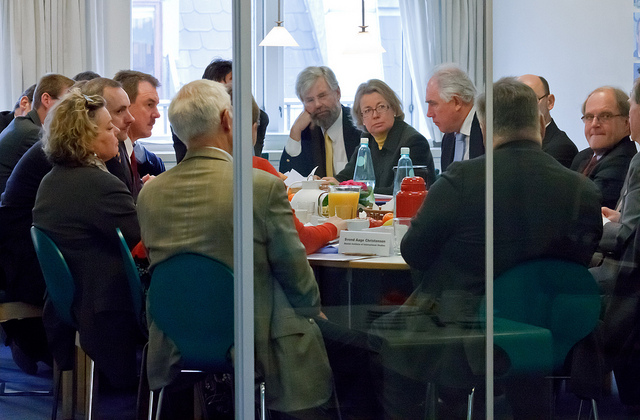15.3 Meetings
Learning Objectives
- Discuss meetings and their role in business communication.
- Describe the main parts of an agenda.
- Discuss several strategies for effective meetings.
Figure 15.2
Meetings are group communications in action around a defined agenda, at a set time, for an established duration.
Baltic Development Forum – Kristovskis-meeting-94 – CC BY 2.0.
A meeting is a group communication in action around a defined agenda, at a set time, for an established duration. Meetings can be effective, ineffective, or a complete waste of time. If time is money and effectiveness and efficiency are your goals, then if you arrange a meeting, lead a meeting, or participate in one, you want it to be worth your time (Mosvick, R. K., 1996).
Meetings can occur face-to-face, but increasingly business and industry are turning to teleconferencing and videoconferencing options as the technology improves, the cost to participate is reduced, and the cost of travel including time is considered. Regardless how you come together as a team, group, or committee, you will need to define your purpose in advance with an agenda (Deal, T., and Kennedy, A., 1982). The main parts of an agenda for a standard meeting are listed in Table 15.2 “Meeting Agenda Elements”.
Table 15.2 Meeting Agenda Elements
| Term | Definition |
|---|---|
| Title Header | Title, time, date, location, phone number, e-mail contact, and any other information necessary to get all participants together. |
| Participants | Expected participants |
| Subject Line | Purpose statement |
| Call to Order | Who will call the meeting to order? |
| Introductions | If everyone is new, this is optional. If even one person is new, everyone should briefly introduce themselves with their name and respective roles. |
| Roll Call | This may quietly take place while introductions are made. |
| Reading of the minutes | Notes from the last meeting are read (if applicable) with an opportunity to correct. These are often sent out before the meeting so participants have the opportunity to review them and note any needed corrections. |
| Term | Definition |
|---|---|
| Old Business | List any unresolved issues from last time or issues that were “tabled,” or left until this meeting. |
| New Business | This is a list of items for discussion and action. |
| Reports | This is optional and applies if there are subcommittees or groups working on specific, individual action items that require reports to the group or committee. |
| Good of the Order | This is the time for people to offer any news that relates to the topic of the meeting that was otherwise not shared or discussed. |
| Adjournment | Note time, date, place meeting adjourned and indicate when the next meeting is scheduled. |
Strategies for Effective Meetings
You want an efficient and effective meeting, but recognize that group communication by definition can be chaotic and unpredictable. To stay on track, consider the following strategies:
- Send out the last meeting’s minutes one week before the next meeting.
- Send out the agenda for the current meeting at least one week in advance.
- Send out reminders for the meeting the day before and the day of the meeting.
- Schedule the meeting in Outlook or a similar program so everyone receives a reminder.
- Start and end your meetings on time.
- Make sure the participants know their role and requirements prior to the meeting.
- Make sure all participants know one another before discussion starts.
- Formal communication styles and reference to the agenda can help reinforce the time frame and tasks.
- Follow Robert’s Rules of Order when applicable, or at least be familiar with them.
- Make sure notes taken at the meeting are legible and can be converted to minutes for distribution later.
- Keep the discussion on track, and if you are the chair, or leader of a meeting, don’t hesitate to restate a point to interject and redirect the attention back to the next agenda point.
- If you are the chair, draw a clear distinction between on-topic discussions and those that are more personal, individual, or off topic.
- Communicate your respect and appreciation for everyone’s time and effort.
- Clearly communicate the time, date, and location or means of contact for the next meeting.
Key Takeaway
With good planning and preparation, meetings can be productive, engaging, and efficient.
Exercise
- Create a sample agenda for a business meeting to discuss the quarterly sales report and results from the latest marketing campaign. Decide what information is needed, and what position might normally be expected to produce that information. Note in your agenda all the elements listed above, even if some elements (such as “good of the order”) only serve as a placeholder for the discussion that will take place.
- Write a brief description of a meeting you recently attended and indicate one way you perceived it as being effective. Compare with classmates.
- Write a brief description of a meeting you recently attended and indicate one way you perceived it as being ineffective. Compare with classmates.
References
Mosvick, R. K. (1996). We’ve got to start meeting like this: A guide to successful meeting management. New York, NY: Park Avenue Productions.
Deal, T., & Kennedy, A. (1982). Corporate cultures: The rites and rituals of corporate life. Reading, MA: Addison-Wesley Publishing Company, Inc.


